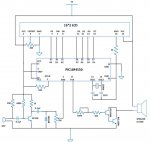erco
Senior Member
I'm working on a music project for the kids, who are learning to play recorders (little flutes). It's simple enough to detect sound versus silence, I'm wondering if there is a simple microphone+audio amp+filter/clip circuit that might condition the recorder sound so a PicAxe could tell the difference between 3 or 4 different tones using COUNT and light different LEDs. The notes can be spaced apart as necessary, don't need to be adjacent.
No doubt, it will come down to the purity of the sound produced (harmonics+other noise) by the recorder. An electronic square wave generator could make audio frequency tones that would be easier to detect, but it would be more magical to use their recorders. My backup plan is using more hardware like several 567 tone decoders, but a software solution would be much simpler.
Has anyone tried anything along these lines? Those little whistle keychain beepers that are nothing but a piezo sensor/speaker and epoxy blob make it look easy.
No doubt, it will come down to the purity of the sound produced (harmonics+other noise) by the recorder. An electronic square wave generator could make audio frequency tones that would be easier to detect, but it would be more magical to use their recorders. My backup plan is using more hardware like several 567 tone decoders, but a software solution would be much simpler.
Has anyone tried anything along these lines? Those little whistle keychain beepers that are nothing but a piezo sensor/speaker and epoxy blob make it look easy.


